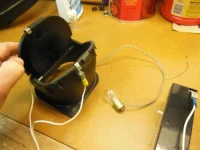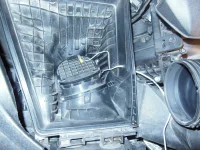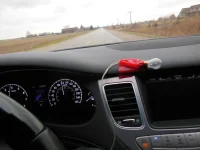I thought I would start a new thread because we were getting a little off topic in the Dead Pedal issue. To summarize my last post, I tried to prove, using math, that the the demands of the engine were greater than what the under-hood induction system (UHIS) could provide.Hence, the need for a secondary air door (flapper door) Some speculated that I didn't take into account enough factors to make the data valid. To a certain extent that was true. The air ingestion rates were based on a 100% efficient system with no bends, leaks or obstructions. I thought that it was much less efficient than the numbers suggested. But, I had no way of proving whether it was 50% or 90% efficient without a flowmeter. Some speculated that ram air pressure would be great enough to close the flapper door at speed. I thought not!
So I set out to do a little experiment with the flapper door. It's a simple electrical continuity test that others should do to validate the results. Here goes.
Purpose: To determine if the flapper door closes at any time during wide open throttle (on a 5.0).
Materials: 15 feet of wire, 12 volt bulb, two contacts, a 12 volt power supply.
See pictures that show bulb on when flapper door is closed. Bulb off when flapper is open.
Method: Accelerate from 35 mph to about 105 mph. Do 2 runs; each one in opposite directions. Also, accelerate at part throttle to determine when flapper door opens. Note: Ram air pressure is negligible below 35 mph. I picked 105 because our trap speeds in the 1/4 mile are about that.
Observation: When throttle was opened the light immediately went out and stayed out up to 105mph.The light came back on when lifting. This was repeated in the second run.
At 2/3 to 3/4 throttle the light would go out at 4000 rpm...until lifting off.
Conclusion: The engine needs more air than the under hood induction (UHIS) can provide.That's why we have a flapper door. Vacuum overcomes the magnet, spring and any ram air pressure that may be in the system.
"THERE IS NO RAM AIR GOING ON HERE!" Sluggo, you were right!
So I set out to do a little experiment with the flapper door. It's a simple electrical continuity test that others should do to validate the results. Here goes.
Purpose: To determine if the flapper door closes at any time during wide open throttle (on a 5.0).
Materials: 15 feet of wire, 12 volt bulb, two contacts, a 12 volt power supply.
See pictures that show bulb on when flapper door is closed. Bulb off when flapper is open.
Method: Accelerate from 35 mph to about 105 mph. Do 2 runs; each one in opposite directions. Also, accelerate at part throttle to determine when flapper door opens. Note: Ram air pressure is negligible below 35 mph. I picked 105 because our trap speeds in the 1/4 mile are about that.
Observation: When throttle was opened the light immediately went out and stayed out up to 105mph.The light came back on when lifting. This was repeated in the second run.
At 2/3 to 3/4 throttle the light would go out at 4000 rpm...until lifting off.
Conclusion: The engine needs more air than the under hood induction (UHIS) can provide.That's why we have a flapper door. Vacuum overcomes the magnet, spring and any ram air pressure that may be in the system.
"THERE IS NO RAM AIR GOING ON HERE!" Sluggo, you were right!
Attachments
Last edited:













